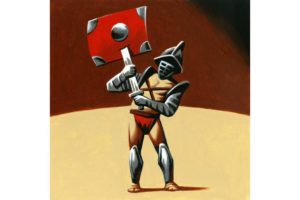WSJ Historically Speaking: A Brief History of Protest in Sports
From angry gladiators to Suffragette sabotage

ILLUSTRATION: THOMAS FUCHS
Sports and protest often go together: As soon as someone makes a call, somebody else is disputing it. But in recent weeks, the really big clashes have happened off the playing fields, as President Donald Trump and others criticized football players kneeling during the national anthem. Such mixing of sports, politics and protest has ancient roots—on the part of both spectators and players.
An early protest by a player comes down to us in “Lives of the Twelve Caesars” by the Roman historian Suetonius (69-130 A.D.). An unnamed gladiator once refused to fight in front of the Emperor Caligula. Then, the gladiator, seeing he would die anyway, grabbed his trident and killed his would-be victors.
But in the ancient world, spectators, not players, were mostly the ones to express their feelings. At Rome’s Circus Maximus in 190 A.D., a young woman followed by a group of children rushed forward during the races and accused an official of hoarding grain. A crowd gathered, threatened the home of Emperor Commodus and succeeded in getting him to fire the official.
Another mass sporting protest wasn’t so civil. In sixth-century Constantinople—the ancestor of the city now known as Istanbul—tensions reached a breaking point between the Blues and Greens, political factions that took their names from colors worn by charioteers. When one side lost at the city’s Hippodrome in 532, a crowd started a mass insurrection known as the Nika Riot. Tens of thousands died in a city whose population was about half a million, and Emperor Justinian never again allowed chariot racing at the Hippodrome.
Perhaps with these rebellions in mind, rulers of the Middle Ages kept sports largely aristocratic, with pageantry in and peasants out. Sometimes, though, a game could be a form of protest. During the heyday of England’s Puritan government in the mid-17th century, some towns rebelled by staging soccer games, which were anathema to Puritans.
Sports regained its full status as a mass spectator event at the end of the 19th century. In 1906 Athens, 10 years after the first modern Olympics, Peter O’Connor, an Irish track-and-field athlete, protested British rule by refusing to accept his silver medal under the British flag. Instead, O’Connor scaled the flagpole and attached an Irish one.
Back home, British sports lovers faced a challenge when the Suffragettes began sabotaging men-only sporting activities. This culminated in a tragedy: During the 1913 Epsom Races outside London, protester Emily Davison ran onto the course, reached for the bridle of King George V’s horse and was trampled to death.
Racism fueled one of the most famous Olympics protests, at the Mexico City games in 1968. American runner Tommie Smith had won the 200-meter race; John Carlos had won the bronze. Wearing no shoes, to symbolize black poverty, the two men raised fists in a black-power salute.
In sports, though, there are many winning plays, and that goes for ways to protest iniquity as well. In 1973, champion tennis player Billie Jean King and some other players were unhappy about the vastly unequal prize money between men and women. Ignored and furious, the women left the circuit and started their own organizing body, the Women’s Tennis Association. The net gains are history.
